Thanksgiving conjures images of stuffed turkeys, cranberry sauce, and pumpkin pies in North America. But what foods do japanese people eat for thanksgiving? Although Japan does not observe the holiday in the same way as the United States, there is a national holiday each November called Labor Thanksgiving Day (Kinrō Kansha no Hi). Despite sharing the word “Thanksgiving,” these two celebrations stem from different historical backgrounds.
In this article, we’ll explore whether the Japanese adopt any Western-style customs, discuss local culinary habits during late November, and see if certain dishes are specifically tied to this Japanese holiday. Along the way, we’ll also answer common questions like Do the Japanese people celebrate Thanksgiving?, What do Asians eat for Thanksgiving?, and How to do Thanksgiving in Japan?
If you’re intrigued about further Japanese eating traditions, take a look at our What Do Japanese Eat for Breakfast to see how morning meals differ from Western norms. Let’s delve into the real story behind Japanese Thanksgiving, from historical influences to modern-day choices, and discover how families might incorporate a holiday meal that fuses domestic and imported traditions.
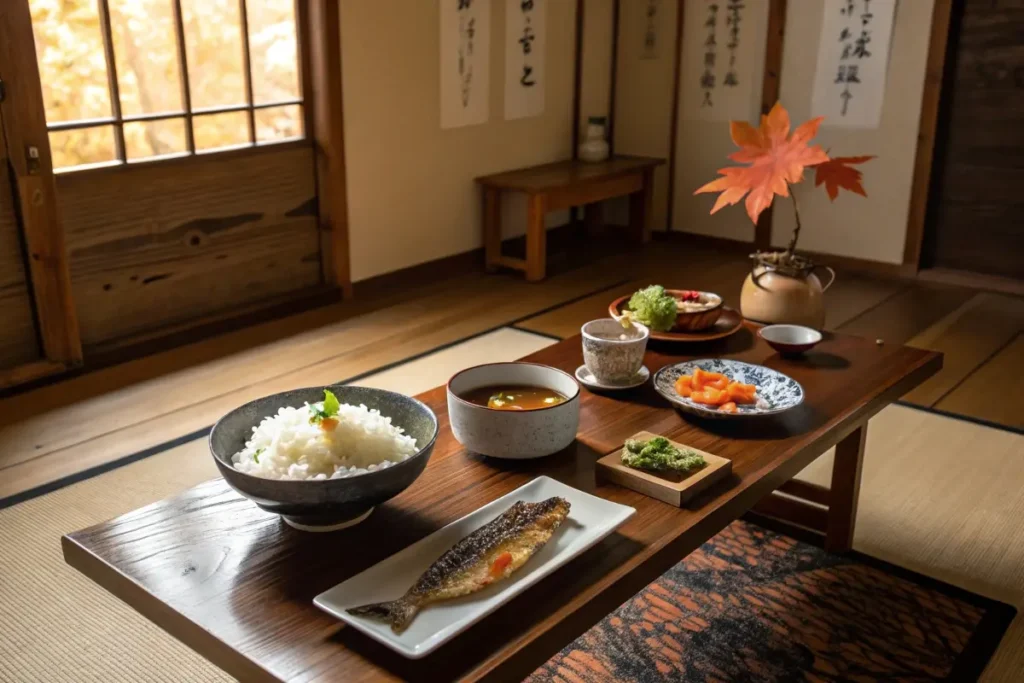
1. Understanding Labor Thanksgiving Day and Its Food Significance
The Essence of Labor Thanksgiving Day
Japan’s Labor Thanksgiving Day, celebrated on November 23, dates back to ancient harvest ceremonies. Formerly known as Niiname-sai (the Harvest Festival), it honored new crops offered to the gods. In the post-war era, the name and focus shifted to highlighting workers’ rights, productivity, and gratitude for the year’s labor. Hence, modern-day celebrations revolve around acknowledging the contributions of workers—farmers, fishers, company employees—rather than feasting like the U.S. Thanksgiving.
Do Japanese People Celebrate Thanksgiving Like Americans?
Not exactly. The day is indeed a national holiday, but there’s no universal custom of gathering for a large feast akin to turkey dinners. Families might enjoy time off, go shopping, or travel. Some might incorporate Western-inspired touches—like roasted chicken or a small baked dish—especially in bigger cities that embrace global trends. However, these add-ons are more personal choices than widespread tradition.
Culinary Customs on November 23
what foods do japanese people eat for thanksgiving remains a nuanced question. While turkey is rarely consumed, you might find:
- Local Seasonal Dishes: Late November sees hearty nabe (hot pot) or roasted sweet potatoes (yakiimo).
- Sushi or Sashimi Platters: Families might pick up fancy sushi for a celebratory meal.
- Western-Influenced Meals: Restaurants might run Thanksgiving-themed promotions, offering small-scale “turkey dinners,” though turkey is not as commonly available in Japan. Some grocery stores carry imported turkey around this time, but it’s still niche.
Gratitude Through Simplicity
For many in Japan, Labor Thanksgiving Day is less about indulging in a large feast and more about spending a quiet moment of appreciation. Students sometimes write thank-you notes to local police or firefighters, and some communities hold small festivals. If a family does gather, the menu could range from typical Japanese comfort foods—like tempura, udon, or grilled fish—to a modest attempt at Western elements.
If you’d like to bring some Japanese flair to your own Thanksgiving-inspired meal, you might check out our Japanese Chicken Fried Rice Recipe to accompany roasted vegetables or even a small turkey portion. This fusion approach can blend the spirit of both cultures: gratitude and hearty shared meals.
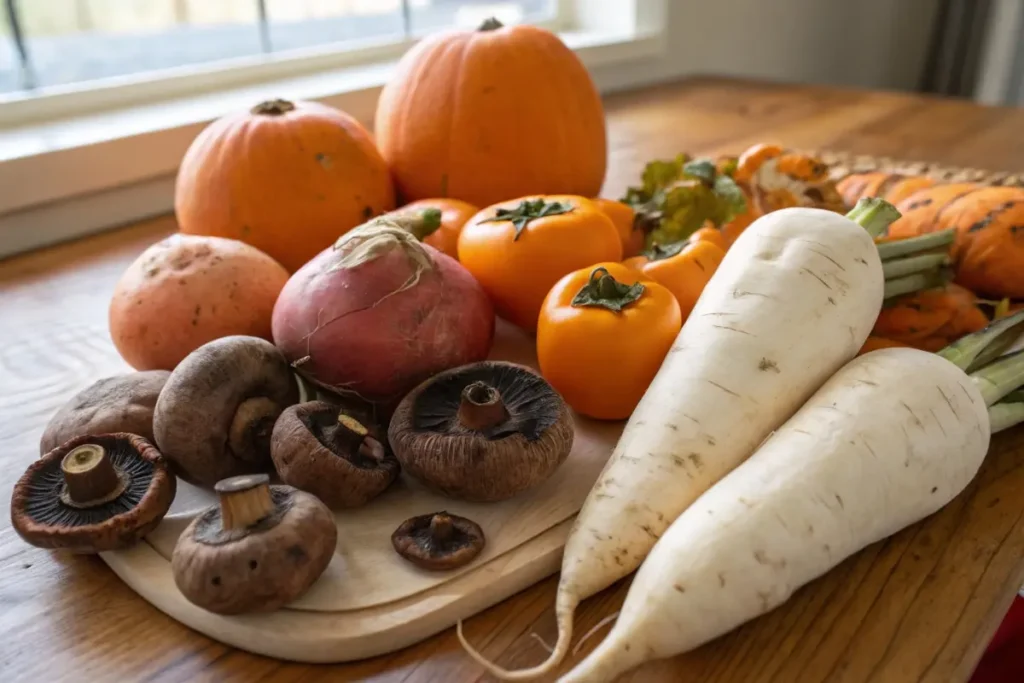
2. Main Dishes and Western Influences
Adaptations of Western Thanksgiving Foods in Japan
While Do the Japanese people celebrate Thanksgiving? typically leads to “not in the American sense,” there’s a noticeable rise in restaurants, bakeries, or supermarkets offering limited Thanksgiving-themed items—like pumpkin pies or small roast chickens—especially in bigger cities like Tokyo and Osaka, where global cuisines mingle freely. Some American expats in Japan make an effort to source turkeys from specialty stores. This can be quite an endeavor, as turkey is not a native poultry in Japan, making it pricier and less accessible.
Replacing Turkey: Chicken, Roast Beef, or Salmon
For those Japanese families wanting a “Thanksgiving-ish” feast, roast chicken is the closest stand-in for the Thanksgiving turkey. Fried chicken is also famously popular in Japan around Christmas, ironically. If poultry doesn’t suit them, some might choose roast beef or grilled salmon for a special dinner. Salmon, in particular, resonates with local palates and fits a celebratory tone.
- Takeout Options: Several takeout chains or supermarkets might offer “party sets,” featuring a variety of finger foods—karaage (fried chicken), potato wedges, mini pizzas. While not strictly Thanksgiving-oriented, they can serve the purpose of a shared meal.
- Western Bakeries: Selling pumpkin pies or apple pies as a nod to autumn celebrations, though they might brand them as “Halloween specials” or “Fall harvest pies” rather than connecting directly to Thanksgiving.
Homemade Approaches
Home cooks who want to adopt an American-style spread might gather recipes for stuffing, cranberry sauce (often replaced with a berry jam or even sweet-savory fruit compotes), mashed potatoes, and roasted vegetables. For dessert, Japanese sweet potato or kabocha (Japanese pumpkin) can easily substitute for typical American pumpkins, making a kabocha pie reminiscent of the U.S. tradition.
Emphasis on Seasonal Freshness
In line with Japanese culinary philosophies, even if they’re trying to replicate a “Thanksgiving dinner,” the selection of produce remains grounded in seasonal offerings. Vegetables might include local mushrooms or daikon. If you’re exploring these ideas, consider our Japanese Sweet Potato Air Fryer Recipe to bring a Japanese twist to a typical potato side. Doing so merges the concept of Thanksgiving’s harvest appreciation with Japan’s own seasonal ethos, yielding a unique, cross-cultural meal that can be both comforting and novel.
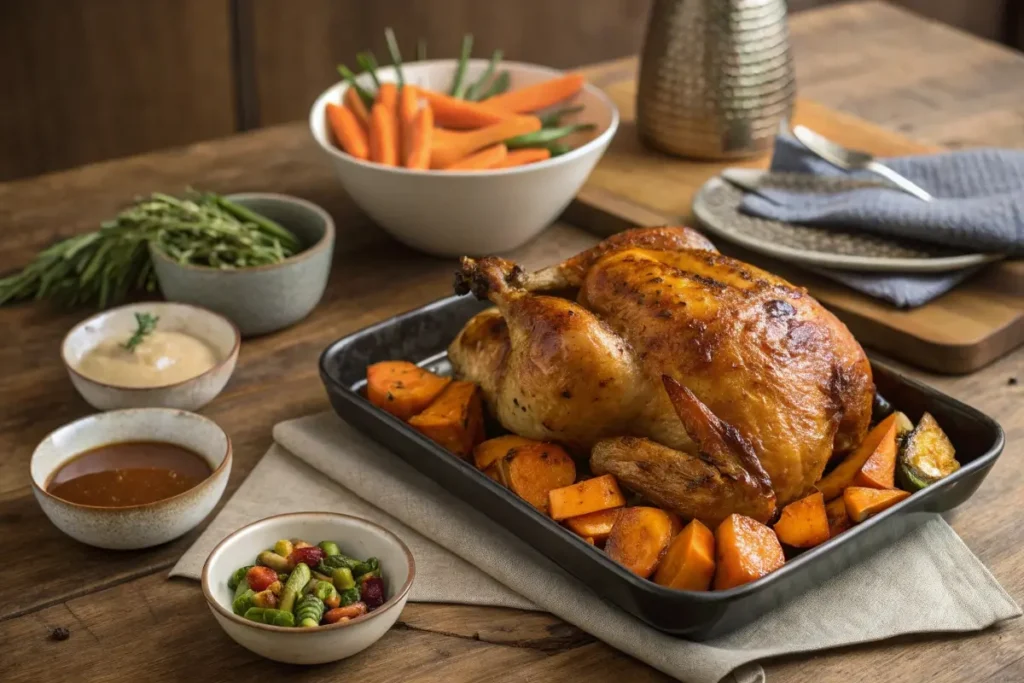
3. History/Context: Japanese Harvest and Gratitude Traditions
Ancient Harvest Rites
Before the concept of a “Thanksgiving Day” in the Western sense, Japan recognized harvest gratitude through ceremonies like Niiname-sai. The Emperor traditionally offered freshly harvested rice to the gods, symbolizing the kami’s blessing for abundant crops. In these ceremonies, only certain individuals (like the Emperor or shrine priests) consumed portions of the offered rice, reinforcing the spiritual link between farmland and the divine.
Transition to Labor Thanksgiving Day
Following World War II, Japan’s constitution and legal structures changed under Allied occupation. The post-war government re-labeled Niiname-sai as “Labor Thanksgiving Day,” focusing on the celebration of workers’ rights, thanks for productivity, and general appreciation for labor efforts. This rebranding preserved the holiday’s November date while shifting the emphasis from purely agricultural thanks to a broader recognition of all contributions in society.
- Why November 23? The date aligns with the traditional harvest timeframe in many parts of Japan—once the rice crops have matured. It remains a day off, but the modern theme is labor appreciation rather than solely harvest devotion.
Historical Shift from Rice to Diverse Staples
Traditionally, rice was the star of any harvest festival. Over centuries, Japan’s diet expanded to include wheat products, sweet potatoes, and eventually Western items like bread or dairy. Despite Western influences, rice remains culturally vital. During Labor Thanksgiving Day, some communities hold small-scale harvest events where children learn about rice planting or local produce. In major cities, though, festivities might be overshadowed by retail promotions or minimal public events.
Distinction from American Thanksgiving
While the American Thanksgiving traces back to pilgrim harvest feasts and turkey remains iconic, Japan’s late-November holiday did not adopt these symbols. Instead:
- No Pilgrim Narrative: There’s no shared historical story of settlers and native peoples in Japan.
- No Universal Turkey Meal: Turkeys aren’t native to Japan, so that tradition never took hold.
- Spirit of Gratitude: Both holidays share an essence of thanks—Americans for historical pilgrim survival, Japanese for labor and harvest—but manifested in different ways.
Modernization introduced a slight blending of Western tradition, so you might see turkey roasts or small “Thanksgiving deals,” especially in international restaurants or on U.S. military bases in Japan. However, the heart of Japan’s Thanksgiving parallel remains tied to a centuries-old harvest ethos, culminating in a modern holiday that underscores community contributions.
For an example of how traditional Japanese culinary roots persist, check out our Traditional Japanese Desserts Recipe. Sweet treats such as wagashi tie back to historical practices of using local beans, fruits, and grains, indirectly reflecting the agricultural gratitude that underscores Japan’s mindset about food.
4. Practical Examples/Use Cases
Even if what foods do japanese people eat for thanksgiving has no singular answer, people incorporate casual or novel traditions into their late-November routines. Here are some practical scenarios that highlight how this holiday might be celebrated in Japan.
1. Home Gatherings with a Twist
- Scenario: A small group of friends living in Tokyo decides to mark November 23 in a mini “Thanksgiving style.”
- Approach: They order takeout roast chicken or pick up a small turkey from an international grocery. Sides include sweet potatoes, some local vegetables, and perhaps a pumpkin dessert from a Japanese bakery.
- Benefit: Merges Western flavors with local produce, bridging cultural tastes. Everyone acknowledges the spirit of gratitude, albeit in an improvised format.
2. Culinary Clubs or Classrooms
- Scenario: A cooking class in Osaka might run a “Thanksgiving in Japan” workshop for curious locals or expats.
- Approach: The instructor demonstrates how to make a simple roast chicken, a side of mashed kabocha squash, and a sweet pot of miso soup. Students learn about American traditions while injecting Japanese influences.
- Benefit: Teaches cross-cultural cooking methods and fosters appreciation for each other’s holiday narratives.
3. Restaurant Specials
- Scenario: An upscale fusion restaurant in Kyoto offers a limited “Thanksgiving-inspired tasting menu” around late November.
- Approach: The chef might serve roasted duck or turkey slices in a soy-based glaze, accompanied by mochi stuffing or chestnut rice.
- Benefit: Customers enjoy a fresh gastronomic experience that fuses American holiday flair with Japanese cooking style.
4. Online Meetup for Expats
- Scenario: American and Canadian expatriates in Japan set up a Zoom potluck, each cooking some Thanksgiving dish with a Japanese twist.
- Approach: Attendees show their homemade meals: one might do Japanese Chicken Curry as a main, another crafts a green bean casserole with panko topping. They share cultural anecdotes, bridging the holiday’s significance across oceans.
- Benefit: Fosters a sense of community, letting them celebrate Thanksgiving despite being overseas.
If you’re interested in more hearty dishes that might fit into a pseudo-Thanksgiving spread, consider our Steak Japanese Recipe for a succulent main course that can stand in for turkey, pleasing both local and international guests. Ultimately, these use cases reveal that while Thanksgiving in Japan isn’t official, creativity abounds for those who wish to merge holiday themes with Japanese tastes.
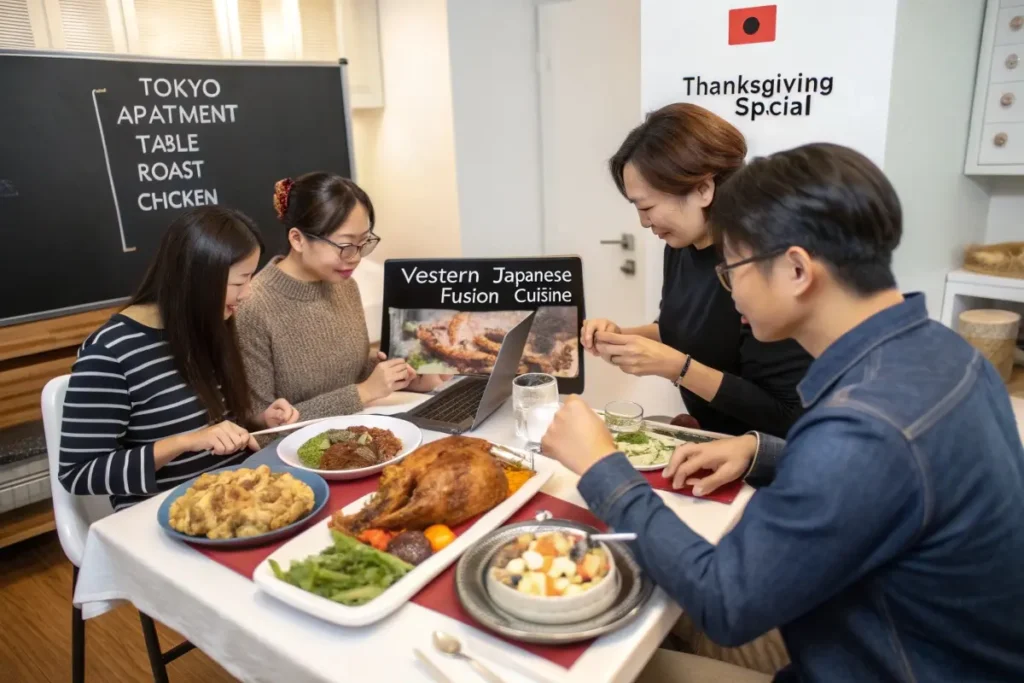
5. FAQs
Below, we answer common queries about what foods do japanese people eat for thanksgiving, clarifying how and if the holiday is observed:
1. What do the Japanese eat for Thanksgiving?
Japan doesn’t celebrate Thanksgiving as Americans do. On November 23—Labor Thanksgiving Day—some families might have a special meal, but there’s no universally accepted holiday dish like turkey. People might eat standard Japanese fare (sushi, fried chicken, hot pot) or adopt minor Western elements.
2. Do the Japanese people celebrate Thanksgiving?
They celebrate Labor Thanksgiving Day on November 23, not the U.S. Thanksgiving. Although the name includes “Thanksgiving,” the day honors workers’ contributions and does not revolve around a large feast. Some folks, especially those with Western connections or living in larger cities, might have small Thanksgiving gatherings.
3. How to do Thanksgiving in Japan?
If you want to host a Thanksgiving celebration in Japan, you can replicate American traditions: track down a turkey at an international supermarket, make sides like stuffing or mashed potatoes, and invite friends to share in the feast. Alternatively, choose local options (roast chicken or fish) for simplicity. Decorations often remain subdued, so a few autumn-themed accents suffice.
4. What do Asians eat for Thanksgiving?
Within Asia, the concept of Thanksgiving is mostly recognized by American expats or local fans of Western culture. Some countries hold harvest festivals with different names and customs. In Japan, a typical feast might incorporate local favorites like sashimi or grilled chicken, depending on personal preference.
5. Do Japanese restaurants serve turkey at all?
Turkey is uncommon in Japan due to limited domestic production. A few Western-style or high-end grocery stores may stock turkeys around this time, but it’s rarely on standard menus. Roast chicken or sometimes duck can appear as an alternative for a celebratory meal.
6. How does this tie to Japan’s harvest festivals?
The modern holiday replaced old harvest ceremonies. Thus, it still fosters a sense of gratitude for nature and labor, albeit with less culinary focus than the American version. You’ll see no mandated special foods—the spirit is more flexible.
Conclusion
While what foods do japanese people eat for thanksgiving might initially suggest a direct parallel to American turkey dinners, Japan’s November 23 holiday—Labor Thanksgiving Day—serves a different cultural purpose. Rooted in harvest gratitude, it evolved to spotlight workers’ rights and productivity, without attaching a single emblematic dish. People often continue everyday culinary practices or might add a small feast, depending on personal preference or exposure to Western traditions.
Curious families or restaurants may adopt elements like roast chicken, pumpkin-inspired desserts, or even minimal turkey options (if they can source it). Yet the overarching theme remains subdued—less about an abundant table, more about reflecting on communal efforts and achievements. This cultural nuance reveals how Japanese society merges global influences with local traditions, yielding a unique blend of mindful appreciation and gastronomic variety.
If you’d like to craft a celebratory meal bridging both cultures, check our Traditional Japanese Desserts Recipe to serve alongside roast chicken or salmon. Whether you keep it purely Japanese or add Western flourishes, the essence of the holiday—gratitude, unity, and reflection—can shine through. Ultimately, Japan’s late November festivities underscore that while the term “Thanksgiving” might resonate differently, the sentiment of giving thanks is universal, beautifully translated through a plate of your choosing.
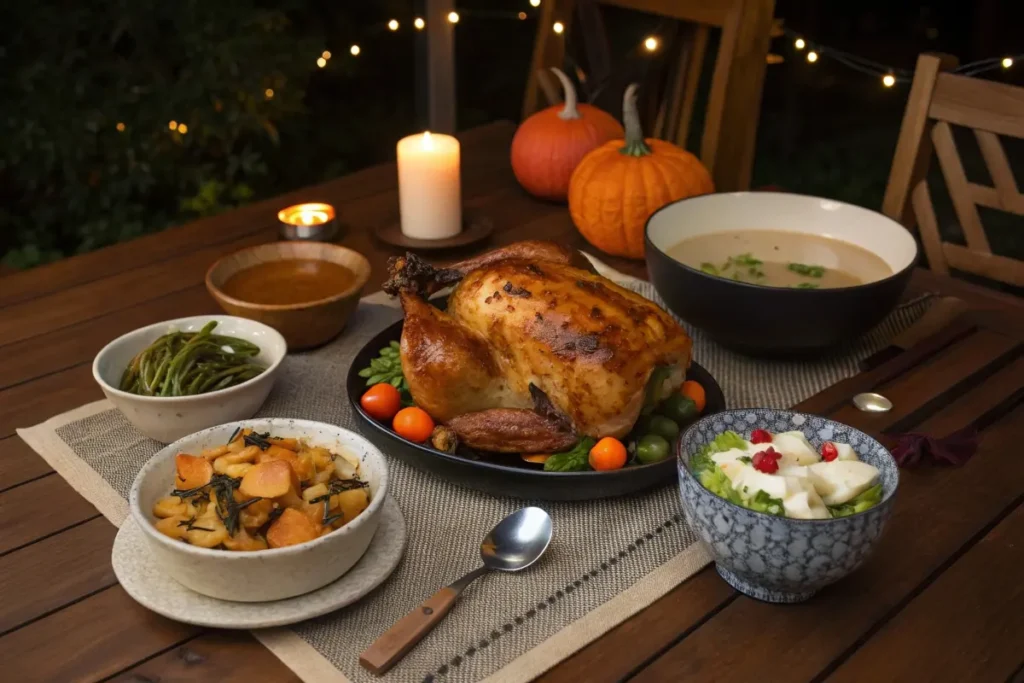
recipe for Thanksgiving Beets
